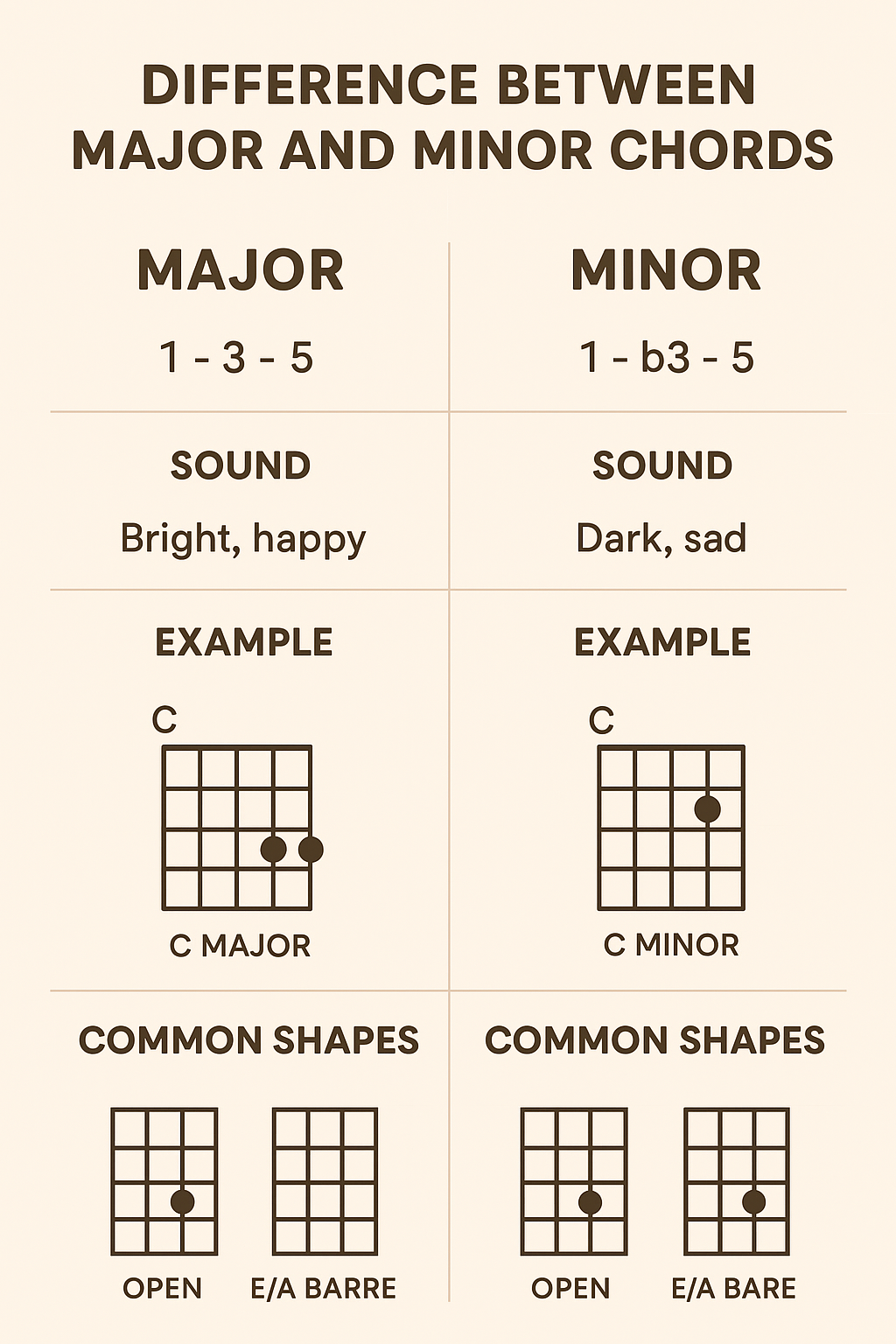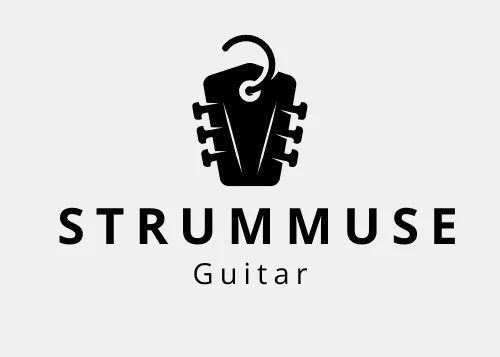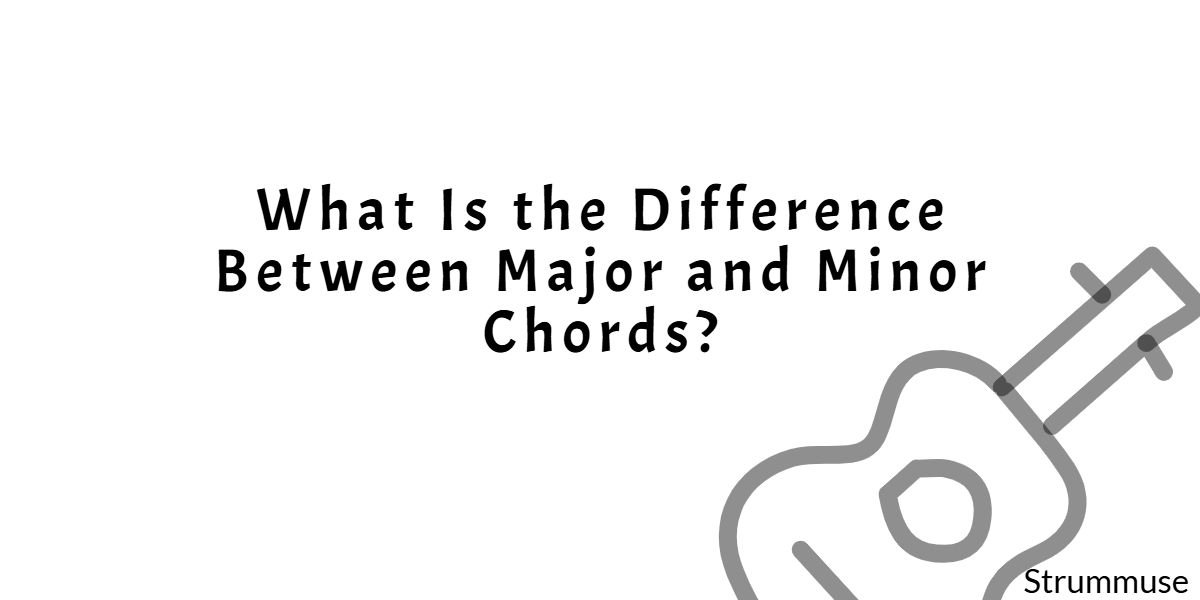Table of Contents
If you’ve ever strummed two chords back to back and noticed that one sounded happy and uplifting while the other felt sad and emotional, you’ve already experienced the difference between major and minor chords.
These two chord families—major guitar chords and minor guitar chords—are the backbone of nearly all Western music. From pop and rock to jazz and blues, the interplay between major and minor is what gives music its emotional depth.
In this post, we’ll explore the difference between major and minor chords from multiple angles: the theory behind them, how they’re played on the guitar, how they sound, and how you can train your ear and fingers to use them confidently.
Why You Should Learn the Difference Between Major and Minor Chords

Many beginners rush past this step and focus only on chord shapes, but here’s why it’s crucial to understand:
- 🎵 Songs are built on them – More than 90% of Western songs rely on major guitar chords and minor guitar chords.
- 🎸 Improvisation – To solo well, you must know if you’re playing over a major or minor chord.
- 📝 Songwriting power – Choosing a major guitar chord vs. a minor guitar chord changes the entire mood.
- 🧠 Deeper fretboard understanding – When you see the logic, not just the shape, you grasp the difference between major and minor chords in every key.
What Makes a Chord Major or Minor?
At the heart of it, what makes a chord major or minor is the quality of the interval called the third. Every basic chord is built on three notes: the root (the starting note), the third, and the fifth. In a major guitar chord, the third is a major third—four half steps above the root. This creates a bright, uplifting sound. In a minor guitar chord, that third is lowered by just one half step, making it a minor third—three half steps above the root. That tiny shift changes the chord’s emotional character completely, giving it a darker, moodier feel. So, the difference between major and minor chords really comes down to just one note—the third—but it’s the note that defines the entire mood of the harmony.
The Music Theory Behind Major and Minor Guitar Chords
The Building Blocks: Triads
Chords are formed by stacking intervals (distances between notes).
- Major guitar chords = Root + Major Third + Perfect Fifth
- Minor guitar chords = Root + Minor Third + Perfect Fifth
👉 The difference between major and minor chords lies in the third.
| Chord Type | Formula | Example (C) | Notes |
|---|---|---|---|
| Major Guitar Chord | 1 – 3 – 5 | C Major | C – E – G |
| Minor Guitar Chord | 1 – ♭3 – 5 | C Minor | C – E♭ – G |
That single note (E vs. E♭) is what creates either a happy/bright major or a sad/moody minor sound.
How They Sound
- Major guitar chords → bright, open, joyful, uplifting.
- Minor guitar chords → dark, sad, introspective, emotional.
This is why the difference between major and minor chords is often explained in terms of emotion: joy vs. sadness.
Playing Major and Minor Guitar Chords on the Guitar
Open Position Chords
Most beginners start with these common shapes:
| Major Guitar Chords | Minor Guitar Chords |
|---|---|
| C Major | C Minor |
| A Major | A Minor |
| E Major | E Minor |
| D Major | D Minor |
Notice how in each pair, the shape changes slightly—usually flattening one note (the third).
Barre Chord Shapes
Barre chords let you move shapes up the neck to create new chords.
- E Major shape → movable for major guitar chords
- E Minor shape → movable for minor guitar chords
- A Major shape → movable for major guitar chords
- A Minor shape → movable for minor guitar chords
Once you understand this, the difference between major and minor chords becomes crystal clear: they share the same skeleton, but one note (the third) defines the mood.
Major and Minor Chords in Scales
Every chord comes from a scale.
- From the major scale, the 1st, 3rd, and 5th notes give you a major guitar chord.
- From the natural minor scale, the 1st, ♭3rd, and 5th notes give you a minor guitar chord.
| Scale | Chord Derived | Notes |
|---|---|---|
| C Major Scale (C–D–E–F–G–A–B) | C Major | C–E–G |
| C Minor Scale (C–D–E♭–F–G–A♭–B♭) | C Minor | C–E♭–G |
This connection explains why the difference between major and minor chords is not random—it’s built into the very structure of music.
Ear Training: Hearing the Difference
A key part of mastering this is being able to hear the difference between major and minor chords.
👉 Try this exercise:
- Play C Major (C–E–G).
- Play C Minor (C–E♭–G).
- Alternate and notice the mood change.
Over time, you’ll instantly recognize whether a song leans on major guitar chords or minor guitar chords.
Recognizing Major and Minor Chords by Ear
One of the most valuable skills a guitarist can develop is the ability to recognize major and minor chords just by listening. The easiest way to train your ear is to pay attention to the emotional quality of the sound. A major guitar chord usually feels bright, strong, or happy—as if it wants to lift the melody upward. In contrast, a minor guitar chord tends to sound darker, sadder, or more introspective. Try playing a C Major followed by a C Minor: notice how one feels open and uplifting, while the other feels more somber. With practice, you’ll start noticing these qualities in songs you hear every day. Over time, your brain will instantly pick up the difference between major and minor chords, allowing you to figure out songs by ear and improvise with confidence.
Practice Routines
Exercise 1: Switching Between Pairs
Practice moving between a major guitar chord and its minor guitar chord counterpart (like A Major ↔ A Minor).
Exercise 2: Circle of Fifths
Work through major and relative minor pairs using the circle of fifths.
| Key | Major Guitar Chord | Relative Minor Guitar Chord |
|---|---|---|
| C | C Major | A Minor |
| G | G Major | E Minor |
| D | D Major | B Minor |
This not only trains your ear but reinforces the difference between major and minor chords in context.
Exercise 3: Play Real Songs
- “Knocking on Heaven’s Door” (Bob Dylan) → Mix of major and minor.
- “Nothing Else Matters” (Metallica) → Strong use of minor guitar chords.
- “Let It Be” (The Beatles) → Uplifting major guitar chords.
Also Check:- Mastering the Strings: How to Practice Guitar at Home Daily
Quick Comparison: Major vs. Minor Guitar Chords
| Feature | Major Guitar Chords | Minor Guitar Chords |
|---|---|---|
| Formula | 1–3–5 | 1–♭3–5 |
| Sound | Bright, happy | Dark, sad |
| Example (C) | C–E–G | C–E♭–G |
| Common Shapes | Open, E/A barre | Open, E/A barre |
| Song Usage | Pop, rock, upbeat | Blues, ballads, metal |
Common Mistakes to Avoid
- ❌ Only memorizing shapes without understanding theory.
- ❌ Confusing major guitar chords with minor guitar chords in barre shapes.
- ❌ Ignoring ear training (the fastest way to feel the difference between major and minor chords).
Also Check:- The Biggest Mistakes I Made as a Beginner Guitarist (So You Don’t Have To)
FAQs on Major vs. Minor Chords
Q1: What’s the main difference between major and minor chords?
The third. Major guitar chords use a major third; minor guitar chords use a minor third.
Q2: Do major chords always sound happy and minor always sad?
Generally yes, but context matters. Jazz, for example, can use minor guitar chords in mysterious or complex ways.
Q3: Which should I learn first?
Start with open major guitar chords (C, G, D, E, A) and their minor guitar chord counterparts (Am, Dm, Em).
Q4: How do barre chords help?
Barre chords make it easy to move one shape and play any major or minor guitar chord across the fretboard.
Q5: How can I practice recognizing the difference between major and minor chords?
Play one after the other. Over time, your ear will instantly hear whether a chord is major or minor.
Conclusion
At its core, the difference between major and minor chords comes down to one note—the third. Yet that one half-step completely changes the mood of the music.
By learning both major guitar chords and minor guitar chords, practicing them in open and barre forms, connecting them to scales, and applying them in real songs, you’ll unlock the emotional palette of the guitar.
Remember: every time you strum a chord, you’re making a choice—joyful brightness or soulful melancholy. That’s the true magic of understanding the difference between major and minor chords.
Visit Srummuse Guitar Store…


Useful Information 🙌